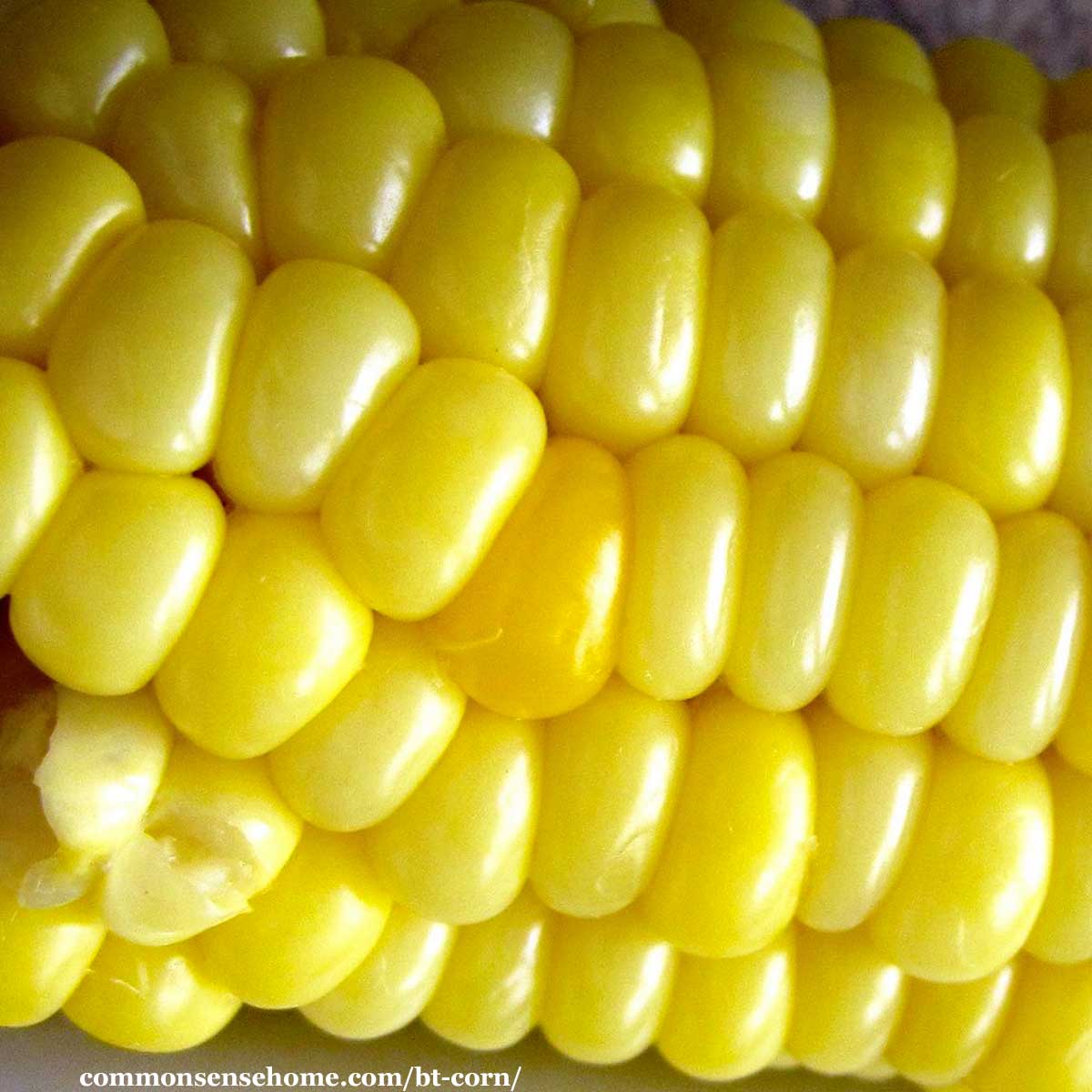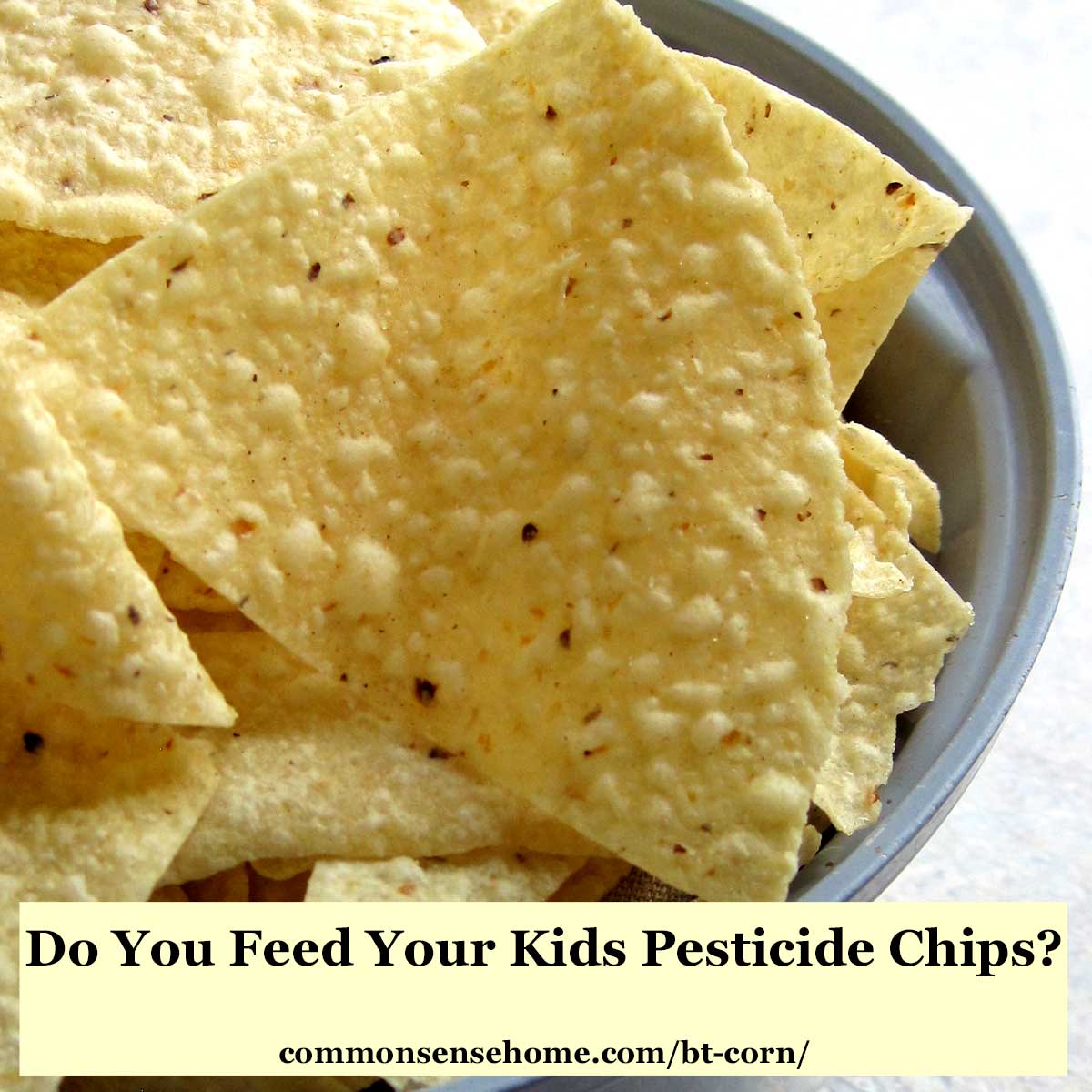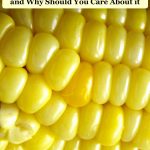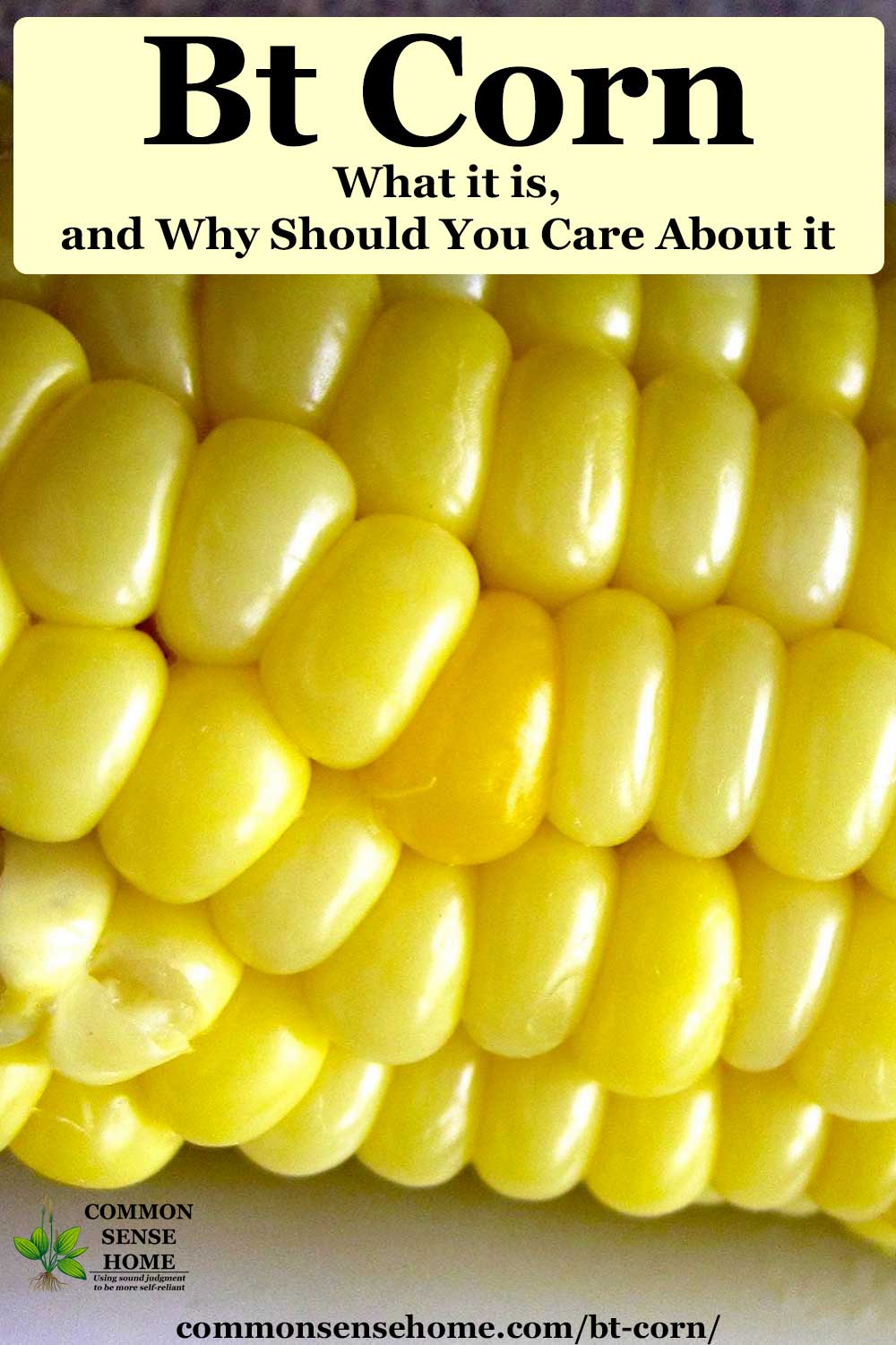Bt Corn – What it is, and Why Should You Care About it
This post may contain affiliate links. Read my full disclosure here.
Most of the corn grown in the United States is Bt corn, but what is it, and why should you care? In this post, we explain the basics of Bt corn and some pros and cons.

What is Bt corn?
Bt corn is corn that is genetically engineered to produce insecticidal proteins from the bacterium Bacillus thuringiensis (Bt). In simple terms, scientists combine corn genes and bacteria genes to make corn that kills bugs that eat the corn.
Bacillus thuringiensis (Bt) bacteria strains occur naturally in the soil. Bt was registered for use as a pesticide with the Environmental Protection Agency (EPA) in 1961. Bt corn came on the market in 1996. There is Bt sweet corn (eaten directly by people) and Bt field corn (used in fuel, animal feed, other products and processed foods).
How does Bt corn kill insects?
Bt affects the larval (caterpillar or grub stage) of the insect. Bt toxins dissolve in the alkaline insect gut, become active, and punch holes in the gut lining. The spores spread out of the gut and germinate in the insect, killing the insect within days of ingestion. (The bug’s guts explode, more or less.)
“Fun” fact – crops that combine the pesticide into the food crop are no longer regulated as food, but as a pesticide. They are regulated by the EPA. (Those tasty corn chips we all enjoy are technically pesticide chips…)
This has been used in court to force municipalities to allow growing Bt crops within their jurisdictions. They can ban food crops, but they can’t ban the use of pesticides. The EPA controls pesticide use, and the EPA says Bt crops are fine. Well, they’re not food, but otherwise they’re fine.

What are the benefits of Bt corn?
The case for Bt corn has always been that it reduces the uses of more toxic, non-specific pesticides. The corn kills the the insects that eat it. As of 2018, about 82% of the corn produced in the United States was genetically modified to include Bt (Bt corn hybrids), according to the USDA.
So what’s the problem with corn that has pesticide built in?
Nature adapts. Corn earworm, western corn rootworm and fall armyworms are developing resistance to Bt corn toxins. The chemical agriculture companies keep creating new hybrids – which work for a while.
Now we see recommendations to plant Bt corn and use insecticide sprays. This is what the corn was supposed to prevent.
From Rutger’s University cooperative extension, “Corn Earworm Developing Resistance to Bt Toxins in Sweet Corn“:
Based upon Galen Dively’s twenty-one years of research comparing non-Bt sweet corn varieties with Bt varieties in plot studies, the proportion of damaged ears in Bt varieties has dramatically increased over that time.
…
What does this mean for our sweet corn farmers? Effective, almost 100% control of European corn borer can be achieved with any of the Bt sweet corn hybrids. Bt hybrids that express only the Cry1 Ab toxin will not control corn earworm and fall armyworm sufficiently so that silking sprays will be needed to maximize marketable yields. Those hybrids expressing Cry1 A.105 and Cry2 ab will probably require some silking sprays, as well.
Non Target Insects Can Die
Pollen from Bt corn kills monarch butterflies. Milkweed is a common weed around the edges of corn fields. Pollen drifts onto the milkweed, and the monarch caterpillars eat it and die.
Would you like to save this?
I’m sure other species are affected, too, like painted ladies, who lay their eggs on thistles. That drifting pollen may also be carried back to the hive by foraging bees, and contributing to colony collapse disorder.
What about livestock?
This is harder to sort out. Adding the Bt gene for pest management isn’t the only modification made to transgenic crops. Many are modified to live through weed killer applications (“RoundUp Ready”). With animals eating genetically modified organisms, impact may be from the food itself or the chemicals sprayed on the food.
A recent Australian study compared pigs fed a diet of genetically modified grains, versus pigs fed non-GMO grains (including Bt corn). The pigs eating GM grains showed much higher levels of severe stomach inflammation.
Is Bt Corn harmful to humans?
Officially, as far as the government and most corporations are concerned – nope. According to UCbiotech.og, “Is the Bt Protein Safe for Human Consumption?“:
The EPA does not require long-term studies because the protein’s instability in digestive fluids makes such studies meaningless in terms of consumer health.
Does Bt really break down in the human gut?
I have concerns about this. If Bt corn (and soy) toxins break down in the digestive system, how do they end up in human blood?
Here’s an example – “Toxin from GM crops found in human blood: Study“:
Till now, scientists and multinational corporations promoting GM crops have maintained that Bt toxin poses no danger to human health as the protein breaks down in the human gut. But the presence of this toxin in human blood shows that this does not happen.
Scientists from the University of Sherbrooke, Canada, have detected the insecticidal protein, Cry1Ab, circulating in the blood of pregnant as well as non-pregnant women.
They have also detected the toxin in fetal blood, implying it could pass on to the next generation. The study covered 30 pregnant women and 39 women who had come for tubectomy at the Centre Hospitalier Universitaire de Sherbrooke (CHUS) in Quebec.
None of them had worked or lived with a spouse working in contact with pesticides.
They were all consuming typical Canadian diet that included GM foods such as soybeans, corn and potatoes. Blood samples were taken before delivery for pregnant women and at tubal ligation for non-pregnant women. Umbilical cord blood sampling was done after birth.
Cry1Ab toxin was detected in 93 per cent and 80 per cent of maternal and fetal blood samples, respectively and in 69 per cent of tested blood samples from non-pregnant women. Earlier studies had found trace amounts of the Cry1Ab toxin in gastrointestinal contents of livestock fed on GM corn. This gave rise to fears that the toxins may not be effectively eliminated in humans and there may be a high risk of exposure through consumption of contaminated meat.
How Much Bt Corn are We Eating?
According to the Corn Refiners Association, nearly 4,000 food items in a typical grocery store contain corn ingredients. And that number doesn’t include all the products—milk, eggs, meat, poultry—that come from corn-fed animals. Or the sweet, whole-kernel corn that comes in cans and freezer bags, and on the cob.
Corn sugar, corn syrup, high fructose corn syrup, corn starch, and thousands of other products – corn is king in the modern grocery store. This link gives a LONG list of potential corn allergens.
This is why we buy organic corn products, as well as organic versions of the other high risks crops (when we buy them at all). It seems like everyone I know is dealing with some sort of inflammation. Maybe this is a piece of the puzzle?
Commonly genetically modified crops include:
- alfalfa
- canola
- corn
- cotton
- papaya
- soy
- sugar beets
- zucchini and yellow summer squash
Does genetic modification concern you or influence your shopping choices, or are you comfortable that GMOs are safe?
You may also find interesting, “Is commercial bread making you sick?“
Originally published in 2011, last updated in 2019.



Thank You.
You’re welcome.
I had no idea I was eating BT corn for the last 28 years! What an eye-opener! I shared on FB and I hope everyone else will, too.
Great post! Thanks!
Did you ask the chip company if they use GM corn?
At the time of this writing, certified organic foods in the US are not allowed to use GMO crops. Given the prevalence of GMOs in certain crops, the odds of other non-certified organic products containing GMOs is extremely high. One woman filed a lawsuit against Frito Lay for advertising their products as “natural” while using unnatural (GMO) ingredients – http://readersupportednews.org/news-section2/312-16/9289-woman-sues-frito-lay-for-marketing-gmo-snacks-as-all-natural.
Yo are the WOMAN. OCD be damned. I appreciate all the hard work you do for us! 🙂 I just get overwhelemd soetimes and don’t have good gardening skills. 🙁 So what is a girl to do? Buy all organic?
Bobbi – life’s a marathon, not a sprint. Just do the best you can, where you are, with what you have. If you change out just one food for a cleaner alternative, you’re better off than you were before. Every day, every week, every year that goes by I learn something new. Sometimes we still eat stuff that we shouldn’t, but we do it less and less. Baby steps are easier than a complete overhaul.
Looks like I missed this the first time around. (Thank you, Facebook!) I avoid corn products like the plague unless they’re organic. For now, I’m letting that be my guide. Of course, I know that there’s a problem with GMO contamination. And trusting the FDA to get it right is not 100% safe. But goodness. I find myself paralyzed sometimes when I’m at the grocery store! Plastic containers, GMOs, BPA, chemicals…
(I was also disturbed to read that GMO potatoes are on the market! Up til now I’ve been avoiding corn, canola, cotton, soy, sugar beets, and GMO papaya. The list keeps getting longer…)
I know! It’s just crazy going shopping. I figure that the less processed food we eat, the better off we are, but I try not to stress too much about every detail, because stress isn’t good for you, either. One day, one meal at a time.
Thank you! I like the idea of experimenting with catnip oil. Yes, a bit pricey, but when I decide to order it, I will come back and order through your page.
I really appreciate the info you pull together. It keeps my head from spinning less. 🙂
I bought my self watering containers a few years ago and now see improved designs which will keep the mosquitoes out. Slow improvements.
Just to add another twist to this (since you’re OCD and will probably want to research this as well) Bt is used (and approved) in organic farming. It isn’t without controversy, but it is another ugly twist to the whole issue. Also Bt is in mosquito dunks. I use mosquito dunks in my self watering containers that I grow my veggies in and it ultimately ends up in my veggies. From what I’ve read there are many variations of Bt, but my head spins when I try to figure it all out.
Cyndy, yes, Bt is used in organic farming, but it’s used very sparingly, by comparison, as a topical treatment, rather than impregnating the plant itself. Since it is basically a naturally occurring bacteria, it makes sense that their would be a variety of strains. Would there be a practical way to screen the standing water in your self-watering containers to keep the wee beasties out? Something else that might be worth experimenting with would be putting a couple drops of catnip essential oil in each container. Catnip oil is supposedly 10 times more effective than DEET as a mosquito repellent, and all natural – http://www.sciencedaily.com/releases/2001/08/010828075659.htm
Since oils naturally float on water, I suspect it would coat the water surface, making it less inviting for the little pests. The oil is fairly expensive, but a little goes a long way.
You can find catnip essential oil online at Mountain Rose Herbs (http://www.mountainroseherbs.com/index.php?AID=120969&BID=10697) or other online herbal sites. Mountain Rose and Frontier are typically my “go to” sites for oils and herbs, which is why I became an affiliate, to a recommend company I trust. (Frontier doens’t currently have an affiliate program.)
Just do the best you can with what you have, and slowly keep improving as opportunities arise.
Costco sells organic tortilla chips at a very reasonable price and they are yummy!
Kathy – did you see the detox post? https://commonsensehome.com/the-autoimmune-epidemic-can-detox-treatments-help/
I'll be adding more as I explore options myself, but this seemed like a safe place to start.
This stuff drives me crazy, too. Poison food in the name of profit.
Oh hell I am not sure I can take this. So much info and a bit freaked out just found your site a week or so ago and I agree, but am not sure how to manage it. I have been sick (am still sick) for a long time and I think it is from toxins that my body has been exposed too. I need basic 101 detox etc…..
Laura – I've been experimenting with drying veggie "chips" in the dehydrator. Once harvest slows down, I may try blending up some corn and seeing if I could make some chips out of that. Any chance you could buy in bulk somewhere, or join a natural foods buying club? These are both ways I keep our food budget in line, but I know it can be tough.
I hate that I can't get chips anymore. The organic ones cost more than I am willing to expend on junk food, and the other ones are not, as you've pointed out, food. And now evil Monsanto is trying to ruin other things, too. Good grief, our yard is too small to grow wheat.
Danielle – we eat chips quite regularly with homemade salsa, too. I know I could make them myself, but there are only so many hours in the day, so meanwhile I'm buying organic.
As we adjust our food budget and slowly make changes, I realized that we eat a lot of tortilla chips, so they are now only organic! Thanks for this informative post; eye opening!
Cecile – yes, often "bad" food is bad on many levels.
Wow love popcorn, just got organic kernels from the store, as I was popping my mom's non-organic orville redenbacher's kernels in the small jug. They say that corn is one of the most important stuff to avoid getting gmo (along with soy and wheat, i believe), but I never knew that the pesticide gene thing was a part of it!! Not to mention, gm crops are unethical, so I choose it because of that. so crazy to learn that one reason why you weren't doing something has more reasons why it's right. happens a lot when you take the plunge into making the better choice.
Stephanie – I hear you! I get so frustrated when I buy a food that I think is "safe", only to get home and read the label in more detail and find it's not what I expected. I've cut back on grains, but going completely grain free would be really tough, especially for the whole family (at least for us). Good luck on your journey.
Thanks so much for this. We have been changing our diet over the last 2 years or so and I am still amazed at how deep the deception goes when it comes to packaged food. We are doing a 30-day grain-free challenge and I'm shocked at how addicted I am! I'm subscribing to your blog – thanks so much for the great info! 🙂
I think going grain free is great if your intention is to have a healthier diet. However there might be good options out there that come from farmers who don’t grow GMO grains. It’s pretty clear that humans depending on blood type can enjoy grains and have a need for this type of food rather than an addiction. I would recommend eating sourdough and getting freshly milled flour if you can. This will reduce gut inflammation from excess gluten and help bacteria aid in the digestion process.
Thanks for taking the time to leave a comment. I think the best thing that all of us can do is led by example and try to tell those who are willing to listen what we know. The internet is a powerful tool, and eventually it's my hope that we can make a difference by getting the word out and voting with our dollars.
I saw this post on The Monday Mania over at the Healthy Home Econimist and I just HAD to read it and I'm so glad I did! We do not purchase anything that is not organic, unless it's local and I know how it was farmed/raised/grown. I'm definitely OCD about avoiding GM foods. I've watched so many documentaries and read tons of books. My heart truly breaks when my family rejects the notion that GM foods are bad and think that they cannot be that horrible and will help feed the hungry. Sigh. I wish I had more friends who I could talk to about these issues. Please write more, I would love to read your thoughts on all of this 🙂